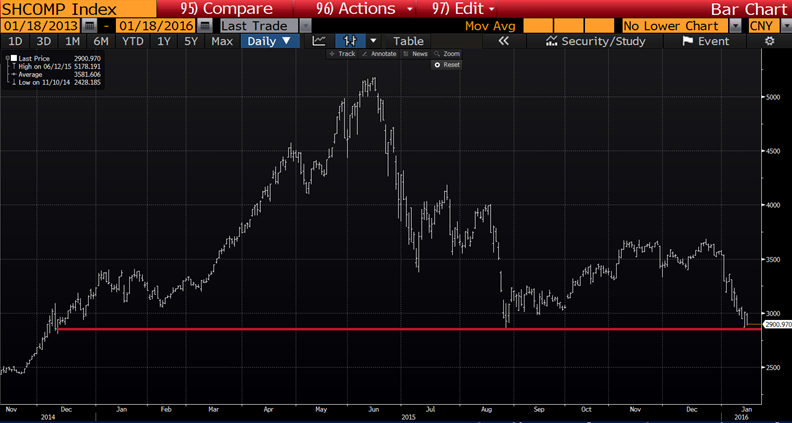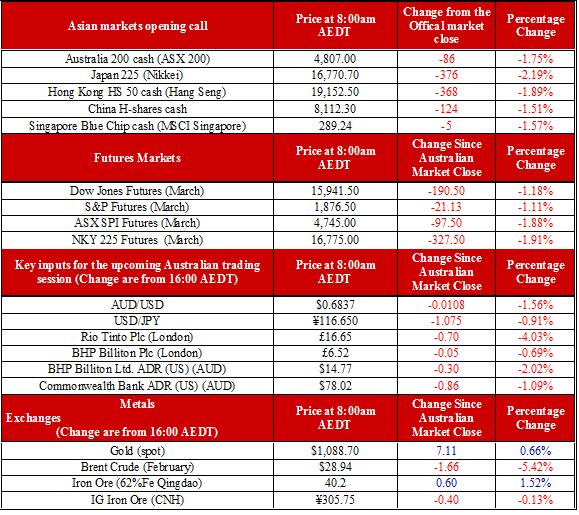Friday’s capitulation in Chinese equities has brought global markets back to the precipice of the August selloff. Most markets globally are teetering on the edge at technical supports that, if broken, through could see another 5-10% loss in value. But Chinese equities’ disproportionate influence on global trade at the moment has markets waiting with bated breath for what the Chinese cash market holds in store today.
The key level to watch today is 2850 in the Shanghai Composite, which was the low in the August selloff. A breakthrough of that level, and Chinese markets are likely to slide down to the 2500 level.

- Global markets are undergoing a major selloff. The big question on every investor’s mind is when we will hit the bottom. It is completely feasible for us to see some sort of a short-term bottom only to see markets sell off even further later in the year. Given such a scenario, it is worth pointing out that Russell Napier has written a whole book on this subject, “Anatomy of the Bear: Lessons from Wall Street’s Four Great Bottoms”. In it, he draws some key takeaways that help indicate markets are timed for a turnaround:
- The cyclically-adjusted PE ratio reaches 4.7x (1932) to 11.7x (1949), or with inflation-adjusted earnings of 5.2x to 9.1x.
- Apart from 1929-32, all major bear markets occurred against a background of economic expansion.
- Return of price stability following a period of deflation, signalling the bottom of the bear market in equities. A stabilisation in commodity prices is key before a turnaround in equities is usually seen, with copper historically being the most accurate predictor of a turnaround.
- In assessing whether price stability is sustainable, investors should look for low inventory levels, rising demand for products at lower prices, and whether producers have been selling below cost.
The book goes into far greater detail, but, in short, on a range of historical indicators we are well away from a bottom. Particularly, given the risks to the global economy from China’s rebalancing, it would be hard to draw the conclusion that we have necessarily seen the worst of the selloff.
- Developments in China will again be pivotal to trade this week. Over the weekend, the People’s Bank of China (PBoC) announced the imposition of reserve requirement ratios for banks with offshore yuan deposits. The PBoC was very successful at blowing out a lot of short CNH short positions last week by intervening heavily to increase interbank lending rates for the offshore yuan (the CNH-HIBOR rate) and dramatically increasing funding costs. This new RRR requirement looks to be a way to permanently elevate funding costs and reduce the need for their daily interventions. Given China is burning through its FX reserves at a rapid clip at the moment, there is a substantial need for them to find a long-term solution to quell offshore CNH volatility. One wonders exactly how costly the last two weeks of intervention were in terms of FX reserves. The other implication of these developments is that China’s steady opening of its capital account looks to be put on pause.
- The China Securities Regulatory Commission (CSRC) released a transcript of an internal meeting on Saturday in which they acknowledged their own ineptitude in handling the market ructions of the past 12 months. In the Chinese context, it does seem particularly significant that the CSRC head, Xiao Gang, is admitting culpability. Rumours were flying that Xiao Gang would resign during the implementation of the new selloff-inducing “circuit-breakers”, and this transcript gives weight to the argument that he may eventually be stood down and scapegoated for China’s mishandling of the markets.
- All this is occurring at a particularly significant time for the Chinese leadership. In 2017, there will be a major reshuffle of the leadership and the jockeying for positions is well underway. But, alongside that, it looks as if there will be a fundamental transformation of the way China governs its financial and economic affairs. There is talk that there will be some sort of “super-agency” that will meld together the three agencies overlooking securities, insurance and banking (CSRC, CIRC and CBRC), and it may even hold sway over other aspects of these portfolios (currently under the control of the PBoC and the NDRC). Lack of coordination between agencies has been a major criticism of China’s handling of the crisis. Chongqing and Bo Xilai’s financial genius, Huang Qifan, has recently been elevated to a senior position in the State Council where he will oversee coordination between these different agencies (for background on Huang, I would highly recommend John Garnaut’s “The Rise and Fall of the House of Bo”). Some major changes in this area appear to be underway.

